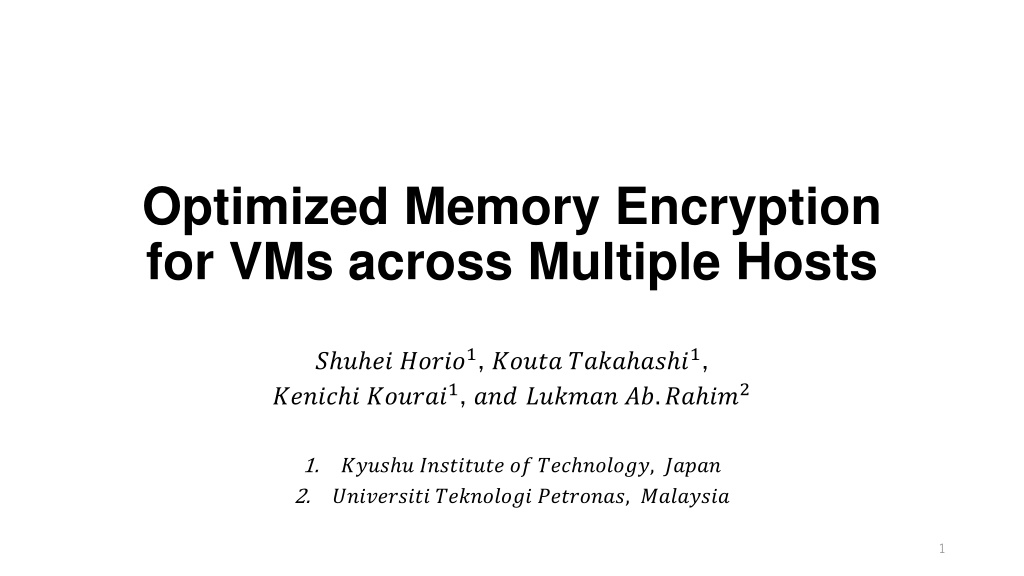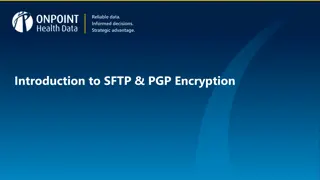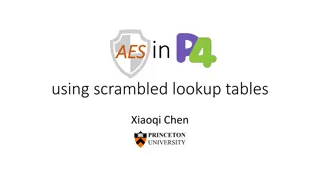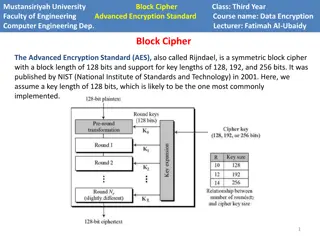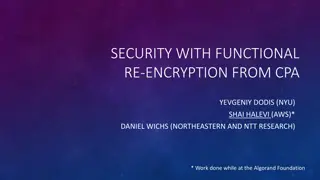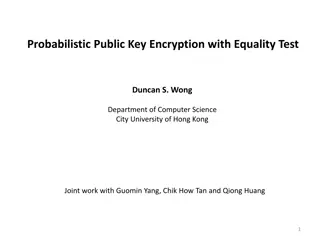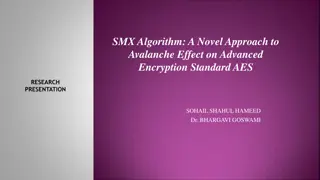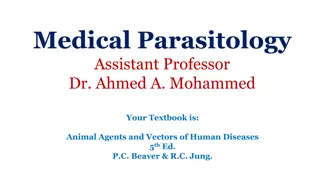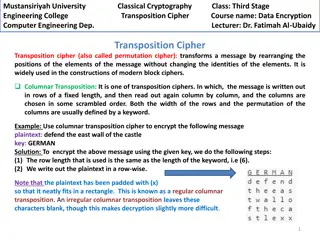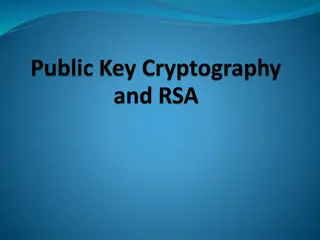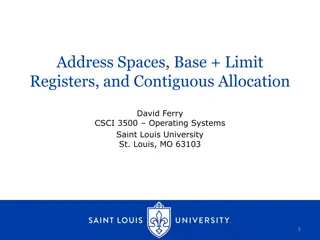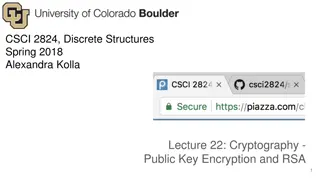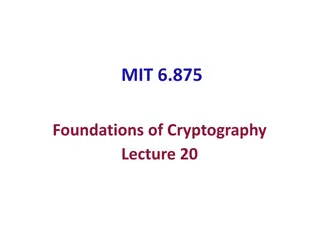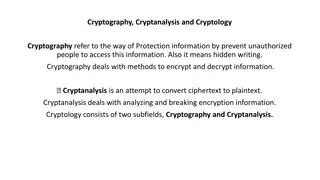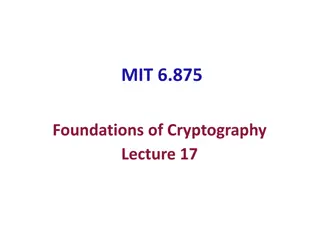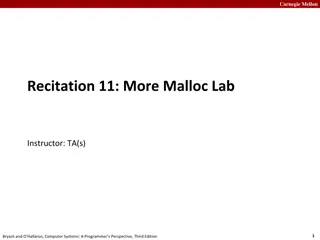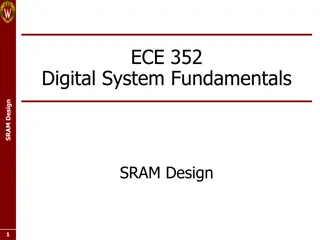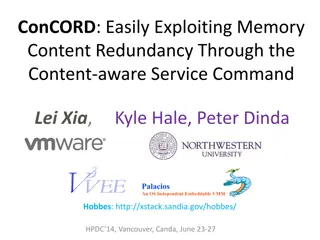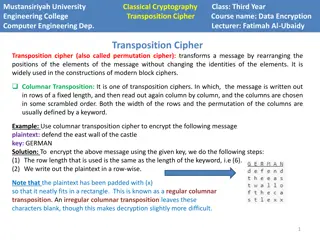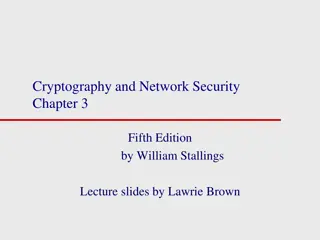Secure Memory Encryption Techniques for Virtual Machines across Multiple Hosts
Virtual machines with large memory capacities are common in cloud environments. To enhance security during VM migrations and data transmissions, techniques like split migration, encrypted split migration, and encrypted remote paging are employed. However, challenges such as data leakage, high CPU utilization, and performance impacts need to be addressed for effective implementation of these encryption methods.
Download Presentation

Please find below an Image/Link to download the presentation.
The content on the website is provided AS IS for your information and personal use only. It may not be sold, licensed, or shared on other websites without obtaining consent from the author. Download presentation by click this link. If you encounter any issues during the download, it is possible that the publisher has removed the file from their server.
E N D
Presentation Transcript
Optimized Memory Encryption for VMs across Multiple Hosts ? ? ?? ?????1, ????? ???? ?? ?1, ????? ? ??????1, ??? ?????? ??.?? ??2 1. 2. ???? ? ????????? ?? ??? ??????, ????? ?????????? ????????? ????????, ???????? 1
Large-memory VMs Virtual machines (VMs) with a large amount of memory are widely used E.g., Amazon EC2 provides VMs with 24 TB of memory VMs are migrated to other hosts upon host maintenance More difficult to migrate a larger-memory VM Require one large destination host with sufficient memory source host destination host migration VM core 24TB 2
Split Migration [Suetake+, CLOUD'18] Migrate a VM to multiple small destination hosts Divide the memory of a VM into small pieces Transfer them to the main host or sub-hosts Perform remote paging to access memory in sub-hosts Run the VM core at the main host Move data from a sub-host (page-in) and to a sub-host (page-out) source host main host sub-host split VM core migration memory VM memory memory remote paging 3
Encrypted Split Migration Information leakage can occur from memory data Data transmission in untrusted networks Untrusted administrators at sub-hosts Encrypt memory data upon split migration Transfer memory data using secure communication channels (SSL) Re-encrypt the data to securely hold it at sub-hosts source host VM memory encrypted sub-host memory main host memory SSL unencrypted re-encrypted 4
Encrypted Remote Paging Encrypt memory data upon a page-in Decrypt requested data at a sub-host Re-encrypt it at the sub-host and decrypt it at the main host using SSL Encrypt memory data upon a page-out Transfer unnecessary data from the main host to a sub-host using SSL Re-encrypt it at the sub-host SSL sub-host memory main host encrypted page-in memory unencrypted page-out re-encrypted 5
Issues of Data Encryption with SSL Large overhead due to always encrypting transferred data CPU utilization becomes 1.7x higher during split migration VM performance becomes 2.2x lower after split migration Insufficient security at sub-hosts Received data is decrypted once by SSL at sub-hosts Re-encrypted data is easily decrypted with the keys stored in sub-hosts 60 60 sub-host execution time[sec] unencrypted CPU utilization[%] unencrypted 50 50 memory encrypted encrypted 40 40 30 30 2.2x 1.7x 20 20 10 10 0 0 6
Our Approach: SEmigrate Optimize memory encryption in split migration and remote paging Avoid decrypting memory data at sub-hosts Reduce the overhead and prevent information leakage completely Selectively encrypt only the memory containing sensitive information Analyze the memory of a VM using VM introspection [Garfinkel+,NDSS 03] source host main host sub-host split VM memory VM memory VM memory encrypted migration remote paging unencrypted OS 7
No Decryption at Sub-hosts Not decrypt or re-encrypt memory data at sub-hosts Encrypt data at the source host without SSL upon split migration Hold it without decryption at sub-hosts Transfer encrypted data as it is to the main host upon a page-in Encrypt data at the main host upon a page-out Hold it without decryption at a sub-host source host main host sub-host split VM memory VM memory encrypted VM memory page-in migration unencrypted page-out 8
Selective Encryption Not encrypt the memory that contains no sensitive data Transfer data without encryption upon split migration Hold it as it is at sub-hosts Transfer unencrypted data to the main host upon a page-in Transfer data without encryption to a sub-host upon a page-out Hold it as it is at the sub-host source host main host sub-host split VM memory VM memory VM memory encrypted page-in migration $ $ unencrypted page-out sensitive data 9
Unencrypted Memory Regions (1/2) Not encrypt free memory The memory regions that are not used by the guest OS in a VM Transfer zero-filled data because old sensitive data may be left Obtain the memory attribute from the guest OS All memory regions are managed by the buddy system in Linux Find the memory region by analyzing its data structure VM SEmigrate guest OS zero-filled data VM introspection 0 transfer free memory 10
Unencrypted Memory Regions (2/2) Not encrypt the memory of the specified applications E.g., in-memory databases that deal with only encrypted data Transfer already encrypted memory data as it is Obtain the process information from the guest OS Find the memory region to which transferred memory data belongs Identify the process that owns that memory region VM DB encrypted by DB SEmigrate guest OS VM introspection transfer 11
Implementation We have implemented SEmigrate in QEMU-KVM 2.11.2 and the memory server Used AES-ECB with AES-NI in OpenSSL and a 128-bit key Ported the LLView framework [Ozaki+, APSys 19] to QEMU-KVM Enable VM introspection using the source code of Linux Support Linux 4.18 as a guest OS currently source host main host sub-host split VM VM VM memory migration guest OS guest OS memory server remote paging QEMU-KVM QEMU-KVM 12
Experiments We examined performance improvement by SEmigrate Run an application using 10 GB of memory in a VM Configure selective encryption so that its memory was not encrypted Comparisons Encrypt all the memory data (AllEnc, baseline) Encrypt no memory data (NoEnc) source/main hosts CPU memory network OS virtualization sub host intel Core i7-8700 64 GB 10 GbE Linux 4.18.17 VM Intel Core i7-8700 64 GB 10 GbE Linux 4.18.17 QEMU-KVM 2.11.2 1 CPU memory network OS CPU memory OS 20 GB Linux 4.18.0 13
Migration Time We performed split migration of the VM The migration time was almost unchanged regardless of encryption SEmigrate could reduce the CPU utilization 6-20% point less than AllEnc The overhead of selective encryption was not small at the source host 100 30 AllEnc SEmigrate NoEnc AllEnc SEmigrate NoEnc CPU utilization[%] 80 migration time[sec] Reduced from AllEnc source host main host sub host 60 20 6% point 13% point 20% point 40 10 20 0 0 14 source host main host sub-host
VM Performance after Split Migration We examined application performance after migration The application caused a lot of remote paging SEmigrate could reduce the execution time by 47% CPU utilization was almost unchanged at the main host It was 26% point less than AllEnc at the sub-host 150 60 AllEnc SEmigrate NoEnc AllEnc SEmigrate NoEnc 125 47% execution time[sec] 50 CPU utilization[%] 100 40 75 30 20 50 10 25 0 0 15 main host sub-host
Conclusion We proposed SEmigrate for optimizing memory encryption in split migration and remote paging Avoid decrypting the memory data of a VM at sub-hosts Reduce encryption overhead Completely prevent information leakage Selectively encrypt only the memory containing sensitive information Further reduce encryption overhead Examined performance improvement by experiments Future work Extend the target of selective encryption to other memory regions Apply SEmigrate to real applications 16
